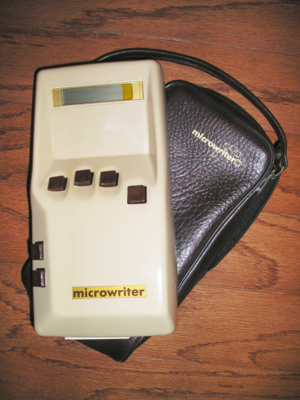| Revision as of 02:35, 20 January 2006 editSteveBaker (talk | contribs)Extended confirmed users, Pending changes reviewers, Rollbackers30,868 edits →External Ports← Previous edit | Revision as of 02:36, 20 January 2006 edit undoSteveBaker (talk | contribs)Extended confirmed users, Pending changes reviewers, Rollbackers30,868 edits →The Microwriter MW4Next edit → | ||
| Line 17: | Line 17: | ||
| * Various interfaces (see below). | * Various interfaces (see below). | ||
| This device was capable of allowing the user to enter and edit several pages of text - and by connecting a printer to the ] connector, documents could |
This device was capable of allowing the user to enter and edit several pages of text - and by connecting a printer to the ] ] connector, documents could be printed without the aid of a separate computer. | ||
| == Keyboard == | == Keyboard == | ||
Revision as of 02:36, 20 January 2006
The Microwriter was a hand-held portable word processor sold in the early 1980's by Microwriter Ltd, of London, UK.
 |
The Microwriter MW4
The 'MW4' Microwriter is believed to be the only model sold in any significant quantity. The 23 cm x 12 cm x 5 cm device comprised:
- A six-button chording keyboard.
- A single line LCD display.
- An 8 bit microprocessor.
- Complete Word processing software in ROM.
- 16 Kbytes of RAM.
- Rechargeable nickel-cadmium batteries - sufficient to run the device for several hours.
- Various interfaces (see below).
This device was capable of allowing the user to enter and edit several pages of text - and by connecting a printer to the RS-232 serial port connector, documents could be printed without the aid of a separate computer.
Keyboard
The innovative keyboard used one button for each finger and two for the thumb of the user's right hand. The five buttons that lay immediately beneath the hand were pressed in different combinations to generate letters A through Z with the second thumb button being used similarly to the Shift Lock key on a conventional keyboard to toggle through a range of modes that would allow you to switch case, enter numbers, punctuation and even ASCII control characters that could be used in editing the document being prepared. Hence to type a letter 'T', one would tap the top thumb button to shift to uppercase - then type a 't' by pressing the index finger and ring finger buttons simultaneously.
This unusual keyboard was suprisingly easy to use - most people could learn to use it in just a couple of hours. With a little practice, it was possible to become a faster typist with the Microwriter than with a conventional keyboard - providing that what was being entered was just text. Things slowed down a lot if a substantial number of special characters had to be entered using the 'shifting' mechanism.
Learning the chords for the basic letters and numbers was facilitated by a set of flash-cards that showed simple mnemonics for each character.
External Ports
At the top end of the unit was a 25 pin D-type RS-232 port and an on/off button. At the other end was the connector for the battery charger and a 49 pin D-type connector that could be hooked up to an optional external unit to allow the Microwriter to be connected to a television and thus to perform full-screen editing. The serial port could be used to connect the Microwriter directly to a printer - or to allow it to be plugged into a computer to function in place of the conventional keyboard.
The fate of the Microwriter
Despite all of this innovation, and the fact that there was no similar product on the market, the Microwriter was not a great success. It is likely that the chording keyboard put off many potential users - which is unfortunate since once introduced to the device, most users could learn it suprisingly quickly.
The keyboard concept was later used in a number of handheld devices manufactured by other companies - but always in addition to a conventional text entry device.